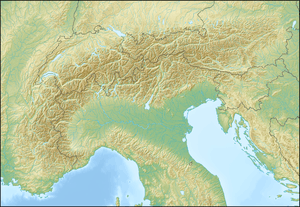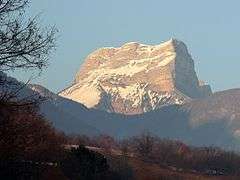Dent de Crolles
| Dent de Crolles | |
|---|---|
|
The Dent de Crolles seen from Saint-Pancrasse (South) | |
| Highest point | |
| Elevation | 2,062 m (6,765 ft) |
| Prominence | 690 m (2,260 ft) [1] |
| Coordinates | 45°18′30″N 5°51′19″E / 45.30833°N 5.85528°ECoordinates: 45°18′30″N 5°51′19″E / 45.30833°N 5.85528°E |
| Geography | |
 Dent de Crolles Location in the Alps | |
| Location | Isère, France |
| Parent range | Chartreuse Mountains |
| Climbing | |
| Easiest route | Through the Col du Coq |
The Dent de Crolles is a karstic mountain (2,062 m) of the Chartreuse Mountains range, 17 kilometres (11 miles) north east of Grenoble, Isère, France. It has a characteristic "tooth-like" profile and is easily recognizable in the Isère Valley (Grésivaudan) in the Grenoble area. Its name is derived from the town of Crolles, located next to the mountain.
Cave system
The réseau de la Dent de Crolles, which lies beneath the summit plateau, is one of the most complex and longest cave systems in Europe, and is considered to be one of the birth places of modern caving. Its first detailed exploration was during World War II by a small team of French cavers which included Pierre Chevalier, Fernand Petzl, and Charles Petit-Didier. Their explorations saw it become the deepest cave in the world at the time with a depth of −658 m (−2,159 ft). The lack of available equipment during the war forced Pierre Chevalier and the rest of the team to develop their own equipment, leading to technical innovation. The first use of the single rope technique with prusik and mechanical rope-ascenders (Henri Brenot's "monkeys", first used by Chevalier and Brenot in a cave in 1934) can be directly associated with its exploration.
Since 1946, the cave has undergone an intense and continuous survey. As of 2010, eleven separate entrances have been discovered. The highest is the Bob Vouay at an altitude of 2,022 metres (6,634 ft) located close to the summit, and the lowest is the main resurgence, the Grotte du Guiers Mort at an altitude of 1,322 metres (4,337 ft), giving a depth of 690 metres (2,260 ft). It is known to include more than 60 kilometres (37 mi) of passages. The cave system is popular for the various through trips that the various entrances allow.[2]
Gallery
- Dent de Crolles shot from Biviers
 Dent de Crolles taken from Montbives
Dent de Crolles taken from Montbives
- The Dent de Crolles taken from the summit of Chamechaude (south-west)
- The Dent de Crolles, the col and the habert des Ayes from the col du Coq (south-west)
- From the summit, a panorama of the Chartreuse massif: the Lances de Malissard overhanging the col de Bellefond
 Map of the Dent de Crolles
Map of the Dent de Crolles
Bibliography (in French)
- La Dent de Crolles et son réseau souterrain, Comité départemental de spéléologie de l'Isère, 1997, ISBN 2-902670-38-9
References (in French)
- Site géologique
- Groupe Montagnard des Petites Roches : informations sur le site d'escalade du Luisset.
- escalade/ski/randonnée à la Dent de Crolles sur c2c
References
- ↑ "Dent de Crolles - peakbagger". peakbagger.com. Retrieved 4 February 2015.
- ↑ Charreton, Philippe. "Historique". Speleo Dent de Crolles. Retrieved 31 October 2016.
| Wikimedia Commons has media related to Dent de Crolles. |